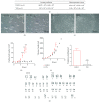Laminin as a Potent Substrate for Large-Scale Expansion of Human Induced Pluripotent Stem Cells in a Closed Cell Expansion System
- PMID: 30805013
- PMCID: PMC6362483
- DOI: 10.1155/2019/9704945
Laminin as a Potent Substrate for Large-Scale Expansion of Human Induced Pluripotent Stem Cells in a Closed Cell Expansion System
Abstract
The number of high-quality cells required for engineering an adult human-sized bioartificial organ is greater than one billion. Until the emergence of induced pluripotent stem cells (iPSCs), autologous cell sources of this magnitude and with the required complexity were not available. Growing this number of cells in a traditional 2D cell culture system requires extensive time, resources, and effort and does not always meet clinical requirements. The use of a closed cell culture system is an efficient and clinically applicable method that can be used to expand cells under controlled conditions. We aimed to use the Quantum Cell Expansion System (QES) as an iPSC monolayer-based expansion system. Human iPSCs were expanded (up to 14-fold) using the QES on two different coatings (laminin 521 (LN521) and vitronectin (VN)), and a karyotype analysis was performed. The cells were characterized for spontaneous differentiation and pluripotency by RT-PCR and flow cytometry. Our results demonstrated that the QES provides the necessary environment for exponential iPSC growth, reaching 689.75 × 106 ± 86.88 × 106 in less than 7 days using the LN521 coating with a population doubling level of 3.80 ± 0.19. The same result was not observed when VN was used as a coating. The cells maintained normal karyotype (46-XX), expressed pluripotency markers (OCT4, NANOG, LIN28, SOX2, REX1, DPPA4, NODAL, TDGFb, TERT3, and GDF), and expressed high levels of OCT4, SOX2, NANOG, SSEA4, TRA1-60, and TRA1-81. Spontaneous differentiation into ectoderm (NESTIN, TUBB3, and NEFH), mesoderm (MSX1, BMP4, and T), and endoderm (GATA6, AFP, and SOX17) lineages was detected by RT-PCR with both coating systems. We conclude that the QES maintains the stemness of iPSCs and is a promising platform to provide the number of cells necessary to recellularize small human-sized organ scaffolds for clinical purposes.
Figures




Similar articles
-
Human Fibrinogen for Maintenance and Differentiation of Induced Pluripotent Stem Cells in Two Dimensions and Three Dimensions.Stem Cells Transl Med. 2019 Jun;8(6):512-521. doi: 10.1002/sctm.18-0189. Epub 2019 Feb 15. Stem Cells Transl Med. 2019. PMID: 30768863 Free PMC article.
-
Suspension culture improves iPSC expansion and pluripotency phenotype.Stem Cell Res Ther. 2023 Jun 6;14(1):154. doi: 10.1186/s13287-023-03382-9. Stem Cell Res Ther. 2023. PMID: 37280707 Free PMC article.
-
Generation of two induced pluripotent stem cells lines from a Mucopolysaccharydosis IIIB (MPSIIIB) patient.Stem Cell Res. 2018 Dec;33:180-184. doi: 10.1016/j.scr.2018.10.019. Epub 2018 Nov 1. Stem Cell Res. 2018. PMID: 30408744
-
Simplified three-dimensional culture system for long-term expansion of embryonic stem cells.World J Stem Cells. 2015 Aug 26;7(7):1064-77. doi: 10.4252/wjsc.v7.i7.1064. World J Stem Cells. 2015. PMID: 26328022 Free PMC article.
-
Differentiation of primordial germ cells from induced pluripotent stem cells of primary ovarian insufficiency.Hum Reprod. 2015 Mar;30(3):737-48. doi: 10.1093/humrep/deu358. Epub 2015 Jan 12. Hum Reprod. 2015. PMID: 25586786
Cited by
-
Atelocollagen supports three-dimensional culture of human induced pluripotent stem cells.Mol Ther Methods Clin Dev. 2024 Jul 20;32(3):101302. doi: 10.1016/j.omtm.2024.101302. eCollection 2024 Sep 12. Mol Ther Methods Clin Dev. 2024. PMID: 39185274 Free PMC article.
-
Polymerized Laminin-521: A Feasible Substrate for Expanding Induced Pluripotent Stem Cells at a Low Protein Concentration.Cells. 2022 Dec 7;11(24):3955. doi: 10.3390/cells11243955. Cells. 2022. PMID: 36552719 Free PMC article.
-
Recommendations for nomenclature and definition of cell products intended for human cardiovascular use.Cardiovasc Res. 2022 Aug 24;118(11):2428-2436. doi: 10.1093/cvr/cvab270. Cardiovasc Res. 2022. PMID: 34387303 Free PMC article.
-
Single-Use Bioreactors for Human Pluripotent and Adult Stem Cells: Towards Regenerative Medicine Applications.Bioengineering (Basel). 2021 May 17;8(5):68. doi: 10.3390/bioengineering8050068. Bioengineering (Basel). 2021. PMID: 34067549 Free PMC article. Review.
-
The Journey of SCAPs (Stem Cells from Apical Papilla), from Their Native Tissue to Grafting: Impact of Oxygen Concentration.Cells. 2022 Dec 16;11(24):4098. doi: 10.3390/cells11244098. Cells. 2022. PMID: 36552862 Free PMC article.
References
LinkOut - more resources
Full Text Sources
Other Literature Sources
Research Materials
Miscellaneous

